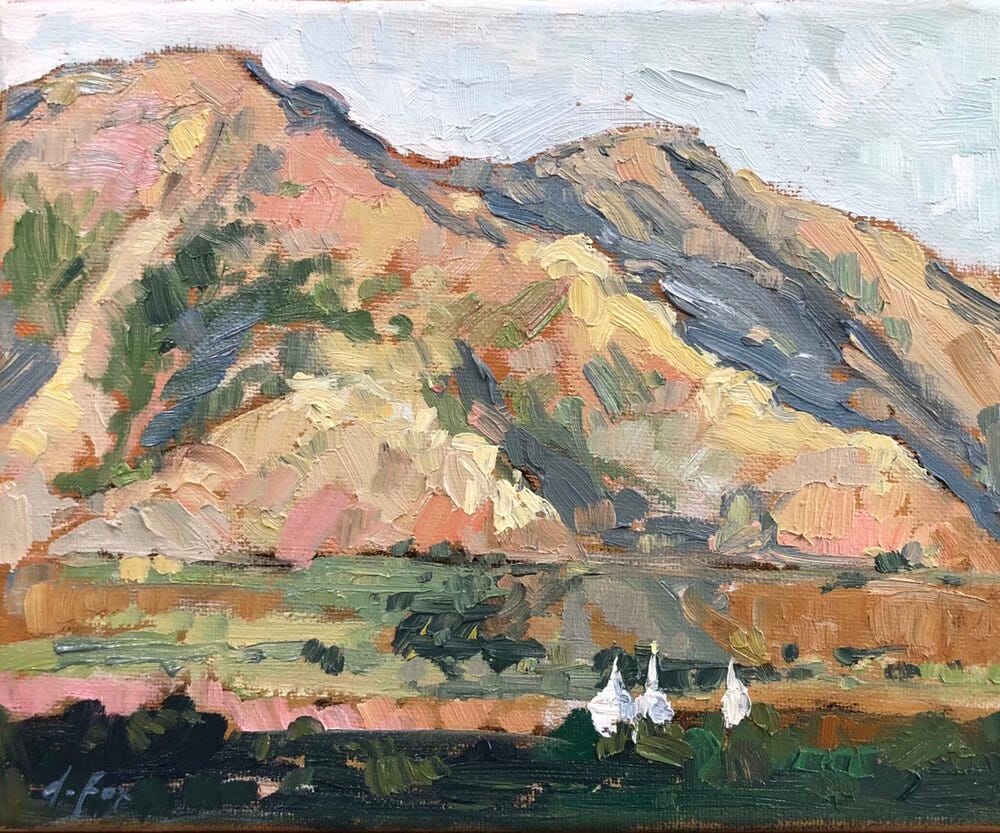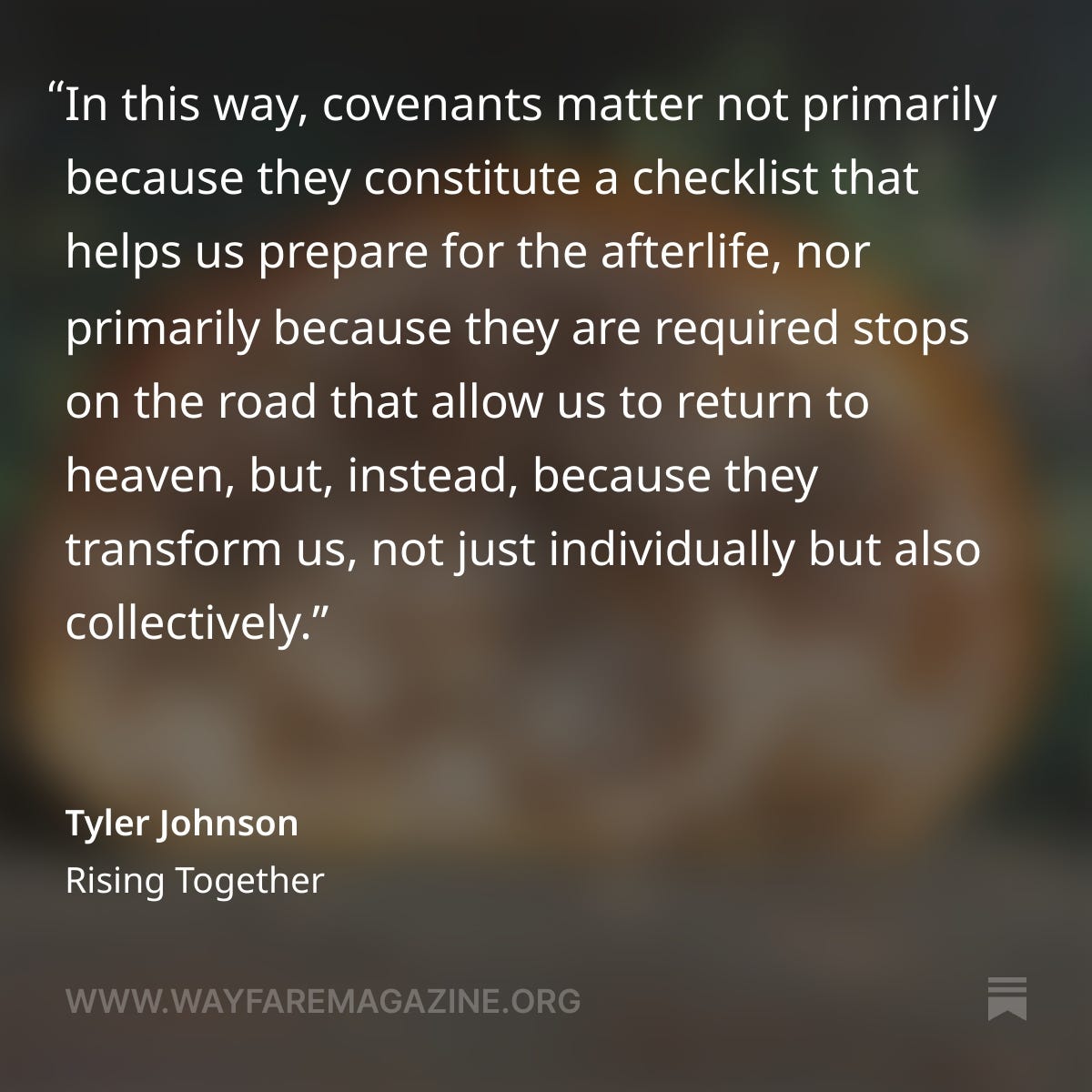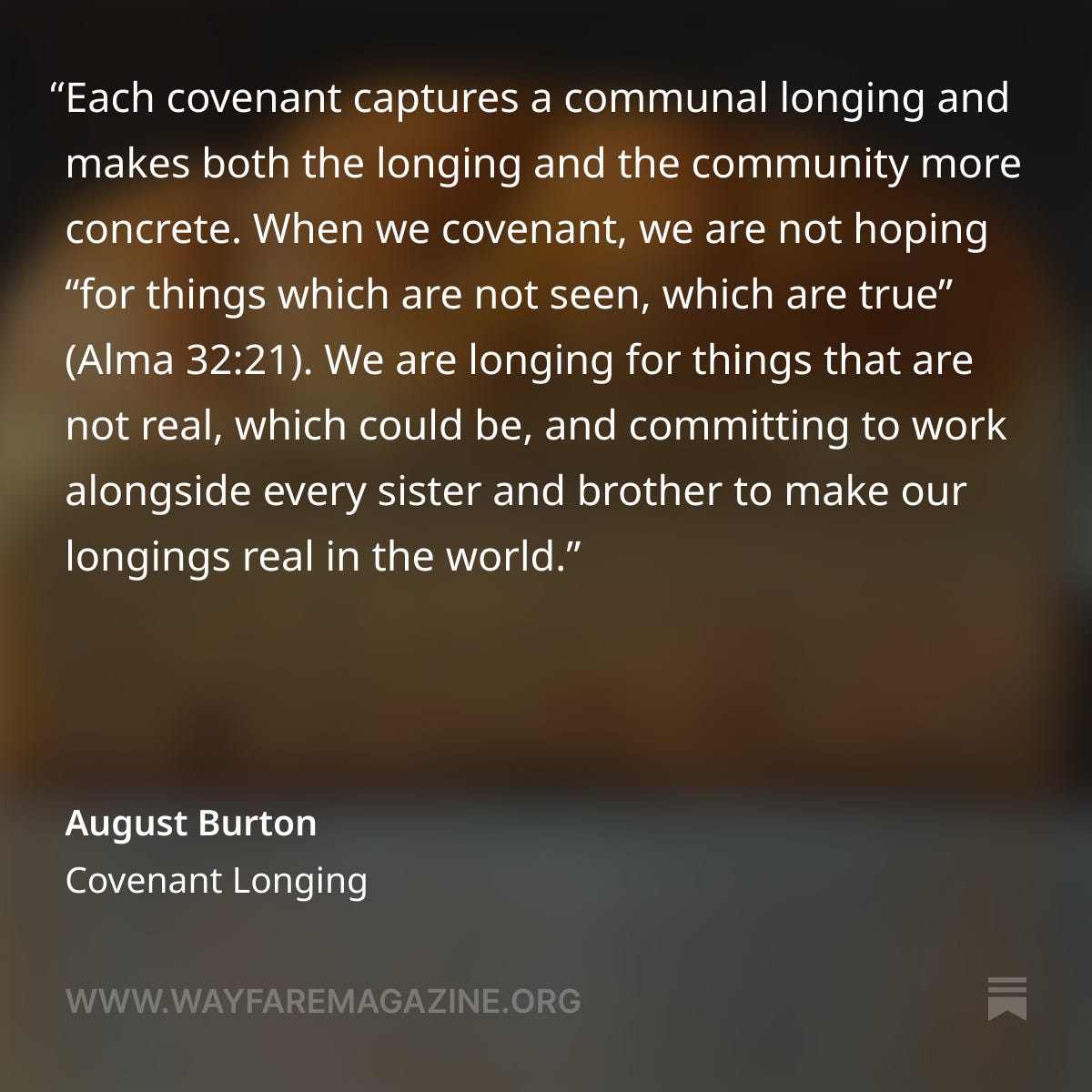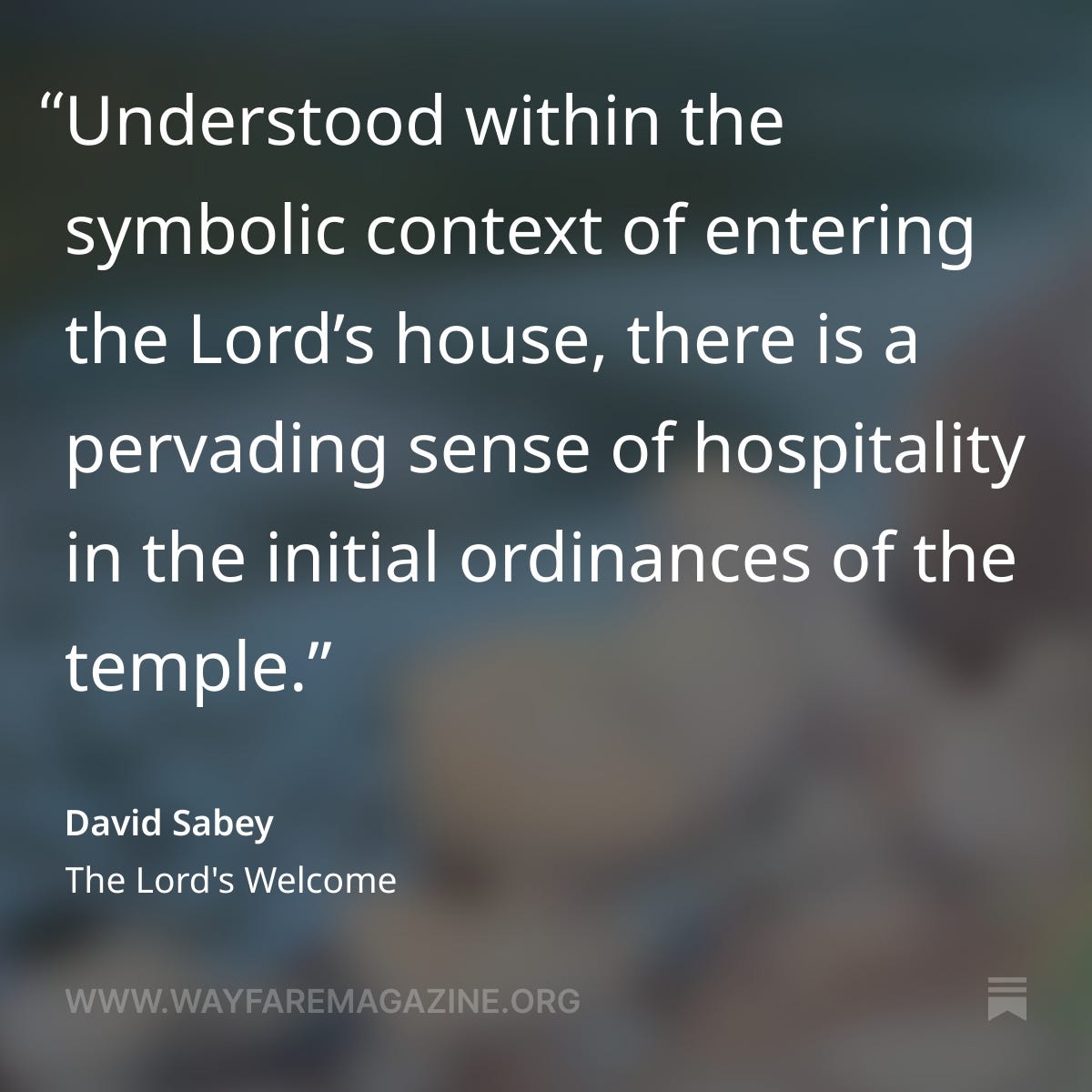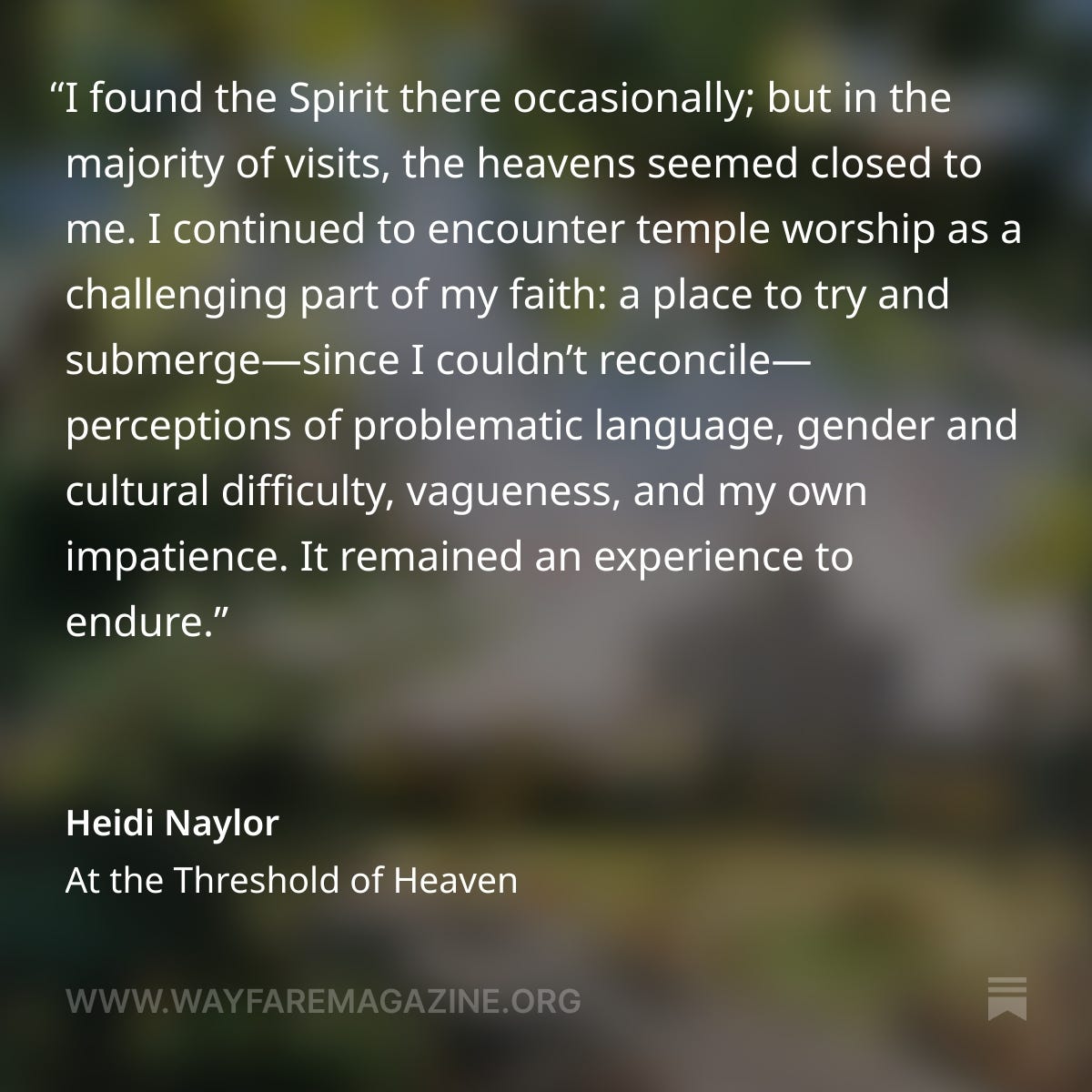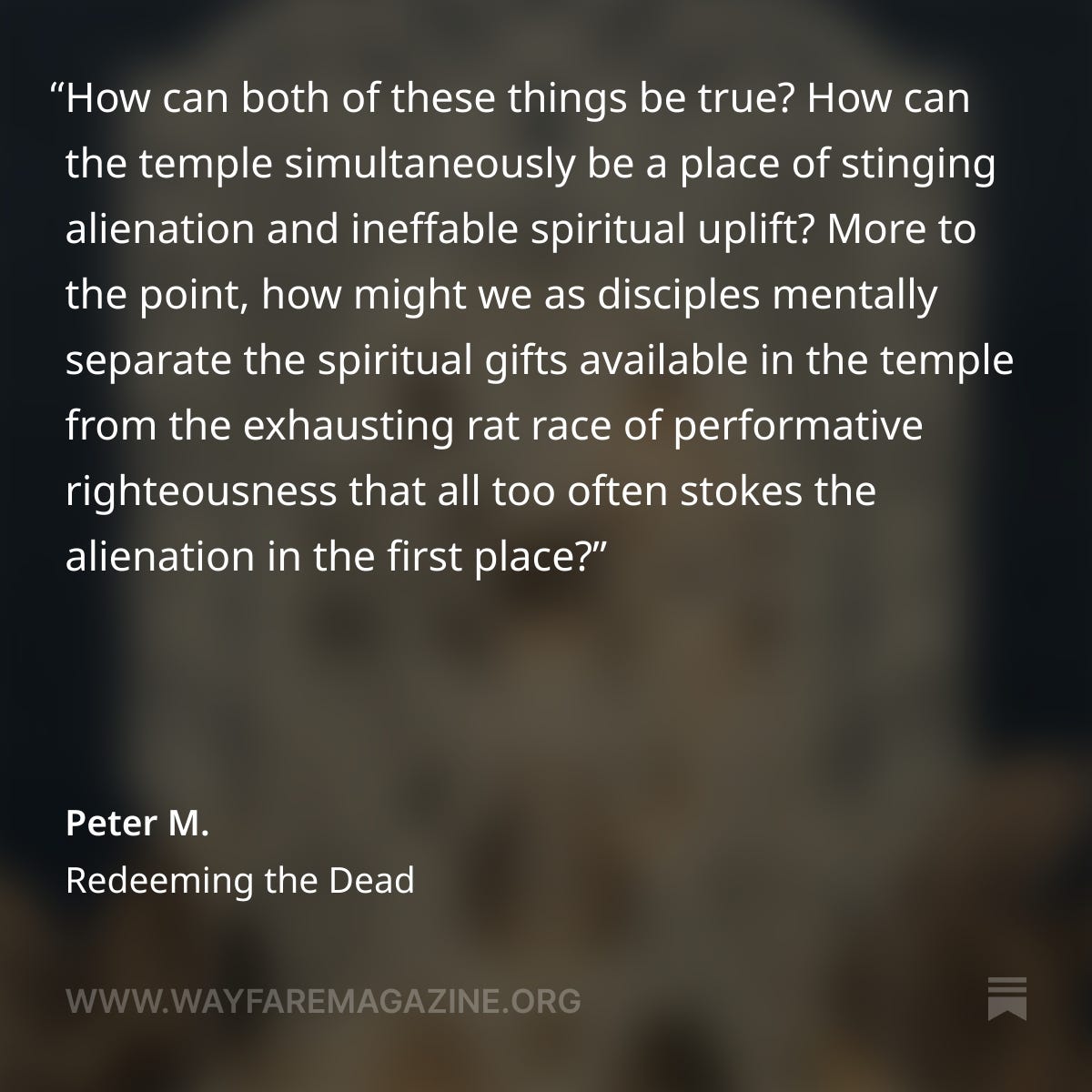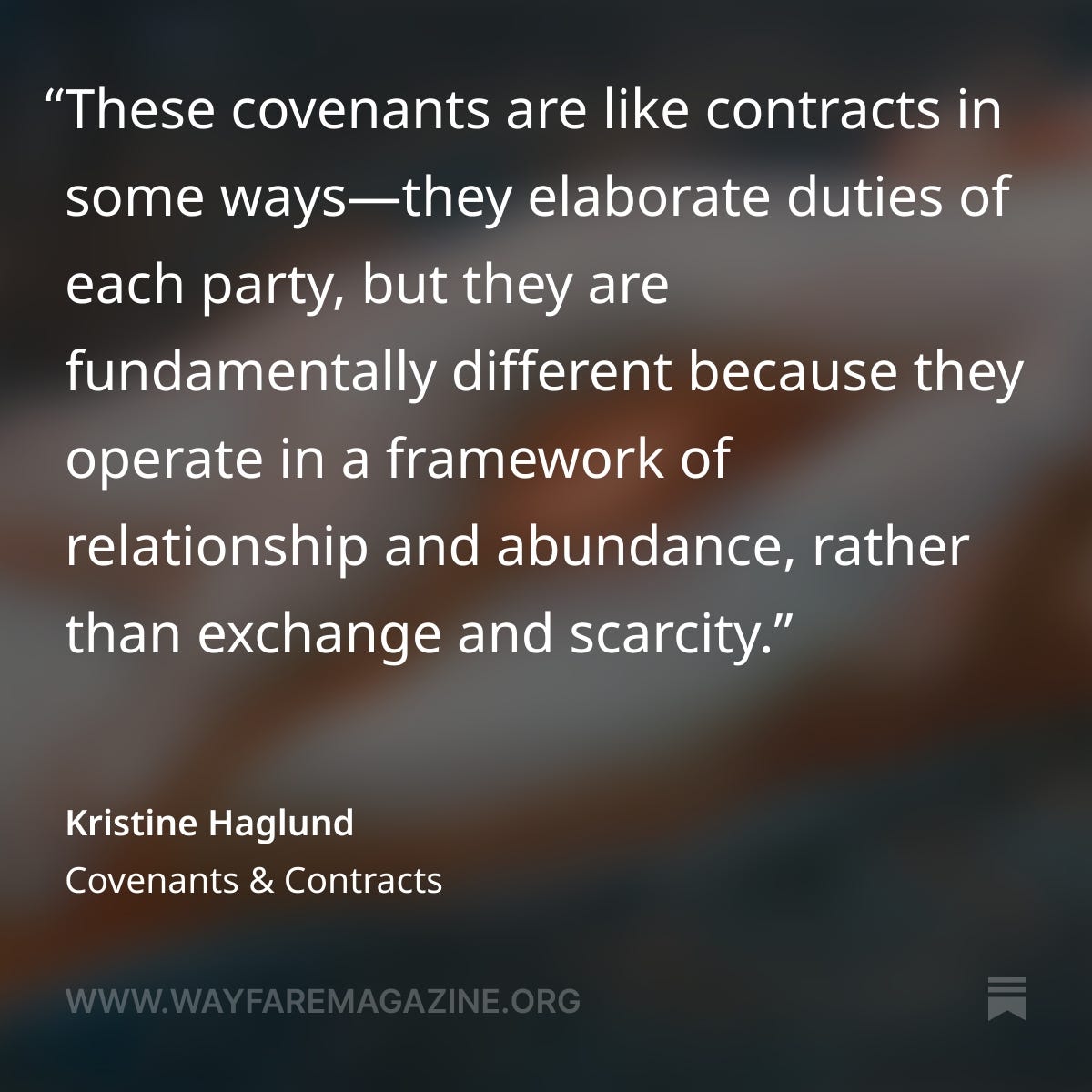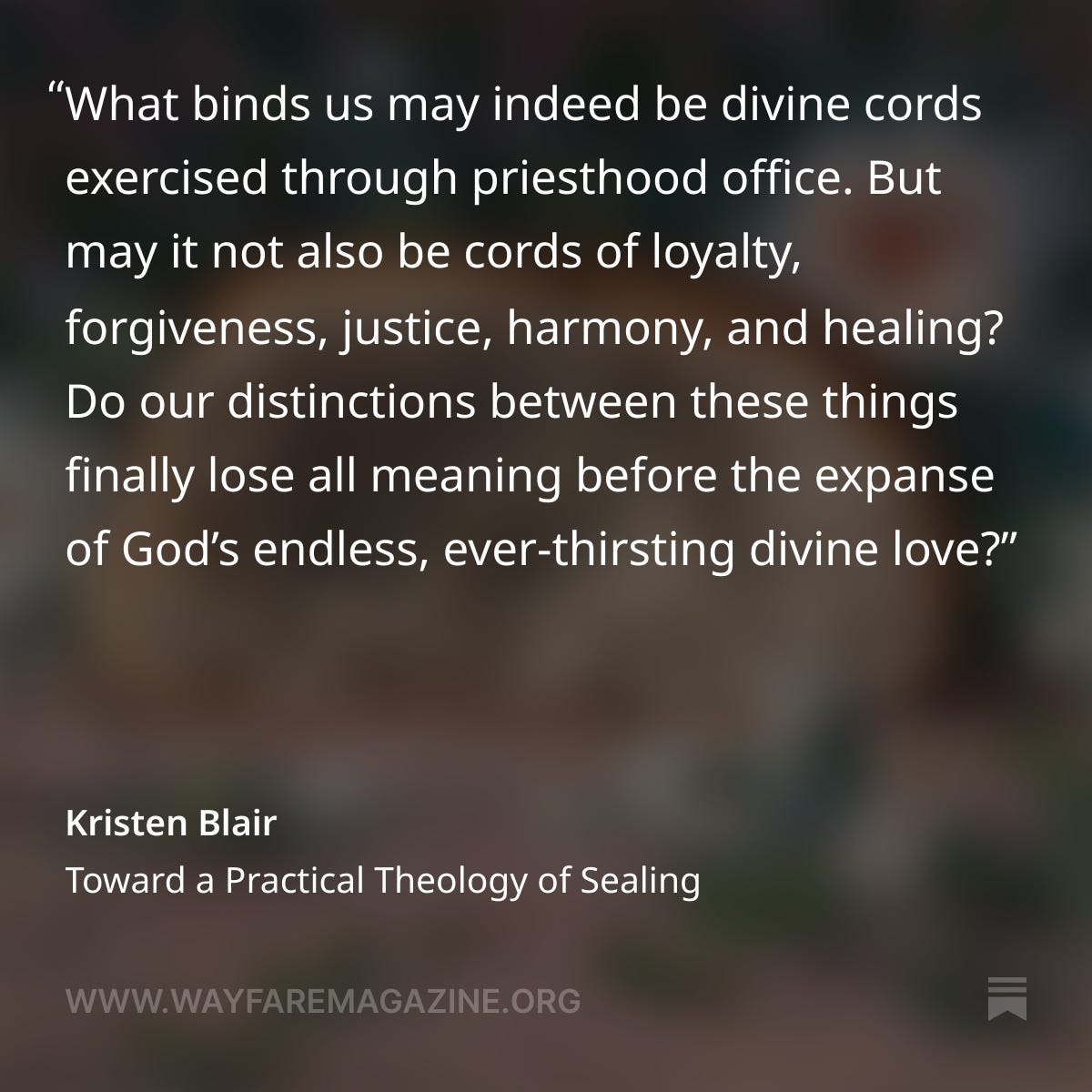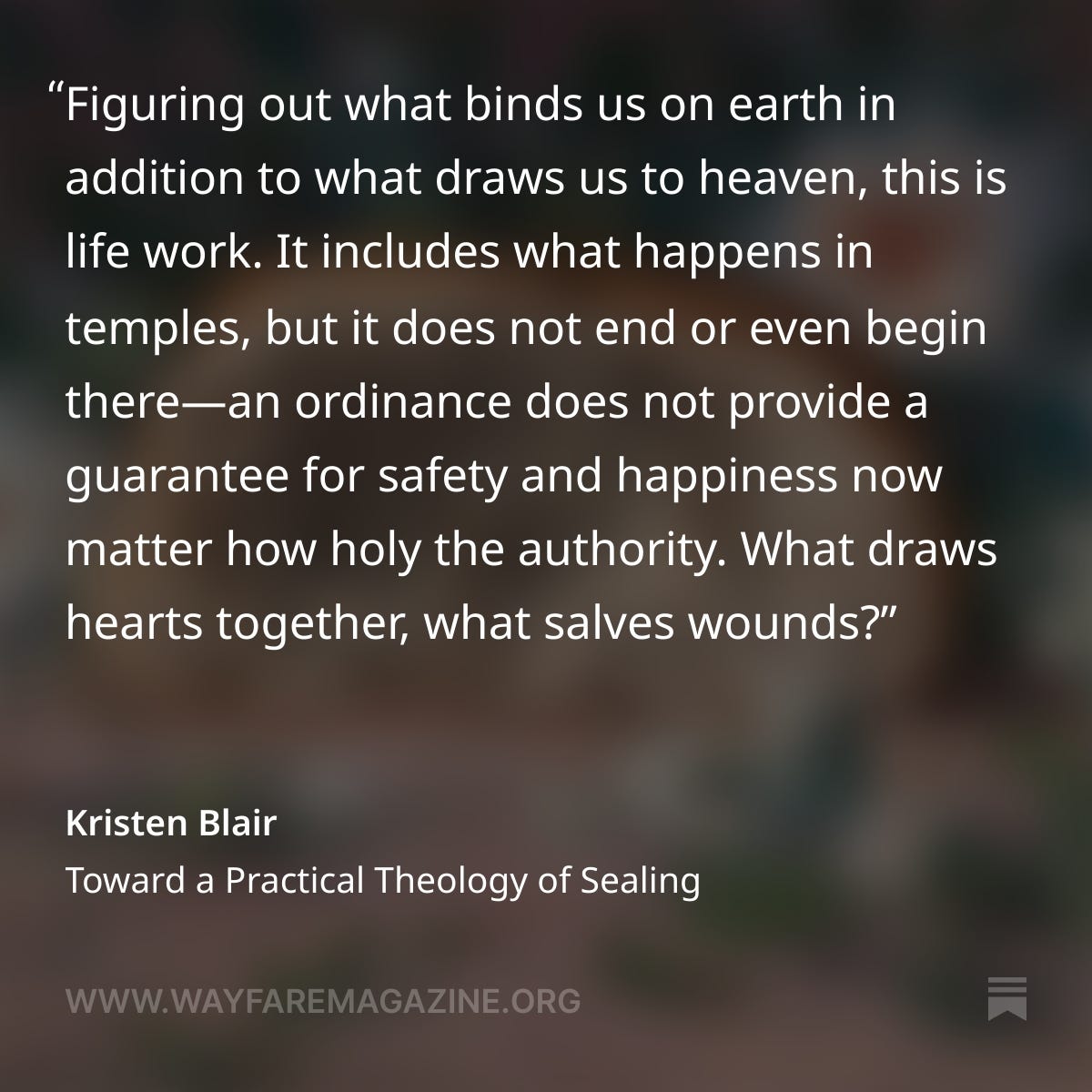Why temples? Why covenants?
Faith Matters resources to accompany your Come Follow Me study: September 29-October 5
The Lord offers me rich blessings through temple covenants.
Find everything we’ve published in Wayfare about covenants here
Temples of the Church of Jesus Christ of Latter-day Saints have a theological foundation that uniquely positions them to be a nexus of the physical and the spiritual, and a joining of liberation and deliverance. When Joseph Smith Jr. dedicated the Kirtland Temple in 1836, he filled the dedicatory prayer with language of fighting oppression. He pleaded with God to “break off . . . [the] yoke of affliction” from a suffering, struggling people, to “have mercy . . . upon all the nations of the earth [and] upon the rulers of our land,” and to arm with power anyone who “go[es] forth from this house” to receive blessings alongside “all the poor and the meek of the earth.”
That dedicatory prayer can be, if we let it, a radical framework committing Latter-day Saint temple goers to unite in global fights against political and spiritual oppression. It can be a foundation for activism that doesn’t divide people’s temporal and spiritual needs.
—Greer Bates Cordner, “D&C 109: Breaking Off Yokes of Oppression”
Could it be that this was the essence of covenant? Fundamentally, it’s not about reciprocal duties, but rather, reciprocal relationship?
And could it be that at the heart of every covenant we make is this one same truth? It’s not just separate and distinct agreements made at baptism, during the sacrament, and in the temple. It’s not a legal contract with pages of clauses. It’s one promise. It’s one choice. It’s saying yes to gracing. Fundamentally, it’s not making covenants (plural), it’s living in covenant (singular). It’s living in Christ.
—Hannah Crowther, “Dancing With Christ” (an excerpt from Gracing)
Theologically speaking, none of us—not even the Church—owns the spiritual blessings of the temple. Yes, the Church pours the concrete and pays the electrical bills, but we make the promises and experience (or not) the spiritual fruits of living them. Choosing to serve in the temple and live the covenants is far less about our standing in the Church than it is about speaking with and worshiping God.
—Peter M., “Redeeming the Dead”
Prayer is communication with Heavenly Father.
Every prayer is unique to an individual and the prayer in your heart can only be prayed to a living God by you and through you. My sense is that God feels great pleasure and joy when we bring that prayer into form.
—Thomas McConkie, “Connection Through Prayer”
The Lord can manifest Himself to me in His house. The temple is the house of the Lord.
Find everything we’ve published in Wayfare on the temple experience here.
At the end of my shift, I take the key out of my pocket and open my locker. I change back into my street clothes and carefully put my temple clothing in my bag. As I walk from the locker room to the exit, I pass those who enter hoping for a spiritual experience that will transcend mere mortality. If there is one thing I have learned, it is that our mortal bodies are essential to performing sacred ordinances for those beyond the veil and to our own spiritual transformation. By becoming a temple worker, I help them in their mortal journey and I find meaning in mine. I’ll be back next week.
—Susan Rugh, “Becoming a Temple Worker”
The temple is a cultic ritual that tells a myth rich in symbolism. The ritualized myth can teach practitioners about life and the eternal. In the temple, Latter-day Saints embody the stories of creation, the fall, and atonement. LDS canon has seven accounts of the creation narrative and four of the myth of Adam and Eve. These stories are our mythos. They are meant to teach us about universal and eternal truths, and they do so through symbolism. In the temple, we relive the story of Adam and Eve as if we were them. Characters in the narrative are not meant to depict what literally happened, but to be symbols of how life works. Because it is symbolic, it can teach different people different truths according to what they need to understand for their own lives.
—Abigail Eve Harper, “Temples of Flesh and Blood”
The Savior directs His work through priesthood keys. The Savior is blessing His people through priesthood keys.
The primary work of LDS rituals is to invite us into relationships. Sometimes the word Church members use to describe these relationships is “covenant,” a term that can feel archaic and even legal. Church members often talk about “covenants” as though they are contracts in which each signatory promises something contingent upon the performance of the other, as though the relationship with God established in the temple endowment ceremony is comparable to executing a mortgage agreement.
… In fact the implication of the rituals themselves points less to commercial contracts, in which two people exchange something, than to the establishment of kinships, which are personal relationships that cannot be obliterated even when one party behaves badly. All throughout scripture, after all, God declares that his covenant with his people will never be canceled even if the people violate it. Isaiah 54:10, for instance:
For the mountains shall depart, and the hills be removed; but my kindness shall not depart from thee, neither shall the covenant of my peace be removed, saith the Lord that hath mercy on thee.
The rituals of Latter-day Saint worship, I think, point us in this direction. They don’t exist to give us information that we need to better fulfill a contract. Instead, they invite us to behave as though we are always already in relationships in which we give to each other out of care and kinship.
—Matthew Bowman, “Rituals of Becoming”
In 2nd Nephi 2 we are taught that “there need be opposition in all things” and Joseph Smith articulated in The History of the Church “that in proving contraries truth is made manifest.” Furthermore Eugene England captured this lived reality in “The Church Is As True As The Gospel” stating “The church is as true, and as effective, as the gospel because it involves us directly in proving contraries, working constructively with the oppositions within ourselves, and especially between people, struggling at an experiential level with paradoxes and polarities that can help to redeem us. The church is true because it is concrete, not theoretical. And despite, even because of its contradictions and problems, it’s as productive of good as is the gospel.” I know that this church is true because in the receiving of priesthood keys it was given a divine, inspired construct. By design it’s meant to humble us to our core, in our service and relationships with one another, so that in doing so, we stand together as the light of the world, so that they may see our good works, and glorify our Father which is in heaven.
—Jason Lonheim, “The Testimony of Jason Lonheim”
The Savior wants me to turn my heart to my ancestors.
Recently I did the unthinkable. I performed temple ordinance work for Beulah Elizabeth Schultz—the other woman who stole Henry’s heart away from my family. I pushed aside the sense of betrayal, as if I was condoning the harm to my family in which she was complicit. But I also had a meaningful sacred experience and felt like the work I was doing was holy—extending an olive branch of reconciliation between Florence, Esther, Henry, Beulah, and my entire family.
I have little clarity on what the whole temple experience means or what realities it brings about. But there is something powerful in the idea that remembering our dead—their suffering, their grief, their sin, their pain, their hopes, their missed opportunities—is in some way redemptive when we seek to make right what was wrong. In remembering Beulah, though we aren’t closely related, maybe I am offering something on behalf of my family that my grandma is no longer able to give but which Beulah can nonetheless receive. And maybe it’s not a betrayal on my part if I am simultaneously reaching for divine healing for all those harmed by this act of betrayal, both among the living and the dead. Maybe I am participating in something redemptive not just for Beulah, but also for my grandma.
I believe that is what Jesus’s grace offers. And as I seek to live in similitude of Him, I believe He asks no less of me.
—Hannah Packard Crowther, “Redeeming” (a chapter from Gracing)
Elder D. Todd Christofferson recently spoke about what happens when hearts of children and parents don’t turn to each other:
It is this free-floating, disconnected state of individuals . . . that would frustrate the very purpose of the earth’s creation. Were that to become the norm, it would be tantamount to the earth being smitten with a curse or “utterly wasted” at the Lord’s coming.
Christofferson was speaking of priesthood sealings connecting individuals. Maybe the storytelling is the prelude, if not the prerequisite, to the sealing work. The storytelling provides the bricks to build our family history.
—Spencer Hansen, “Hearts Shall Turn to Their Mothers”
We are blessed in our faith tradition to have an understanding of families that spreads so much farther and goes so much deeper than just the nuclear family unit. We believe in a family that can be sealed together for eternity, through countless generations, from child to parent to grandparent. It’s a family unit that is just as important and serves just as many purposes as the modern nuclear family. The branches of this eternal family tree spread wide enough to encompass siblings and cousins and aunts and uncles. Even when loved ones have passed from this life, we have the power to graft them onto our living tree through posthumous temple work. And, if you dig down far enough, you’d find that we all spring from the same roots. You. Me. Your neighbor. A stranger on the other side of the planet. Across distance and time, we share both the same heavenly parents and the same physical ancestors. We call each other “brother” and “sister” for good reason.
—Jeanine Bee, “Hymn of the Alloparent”


